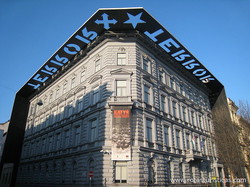




House of Terror is a museum located at Andrássy út 60 in Budapest, Hungary. It contains exhibits related to the fascist and communist dictatorial regimes in 20th-century Hungary and is also a memorial to the victims of these regimes, including those detained, interrogated, tortured or killed in the building.
The museum opened on 24 February 2002 and the Director-General of the museum since then has been Dr Mária Schmidt.
The House of Terror is a member organization of the Platform of European Memory and Conscience.
The museum was set up under the center-right government of Viktor Orbán. In December 2000 the Public Foundation for the Research of Central and East European History and Society purchased the building with the aim of establishing a museum in order to commemorate these two bloody periods of Hungarian history.
During the year-long construction work, the building was fully renovated inside and out. The internal design, the final look of the museum's exhibition hall, and the external facade are all the work of architect Attila F. Kovács. The reconstruction plans for the House of Terror Museum were designed by architects János Sándor and Kálmán Újszászy. The reconstruction turned the exterior of the building into somewhat of a monument; the black exterior structure (consisting of the decorative entablature, the blade walls, and the granite sidewalk) provides a frame for the museum, making it stand out in sharp contrast to the other buildings on Andrássy Avenue.
With regard to communism and fascism, the exhibition contains material on the nation's relationships to Nazi Germany and the Soviet Union. It also contains exhibits related to Hungarian organisations such as the fascist Arrow Cross Party and the communist ÁVH (which was similar to the Soviet Union KGB secret police). Part of the exhibition takes visitors to the basement, where they can see examples of the cells that the ÁVH used to break the will of their prisoners.
Much of the information and the exhibits is in Hungarian, although each room has an extensive information sheet in both English and Hungarian. Audio guides in English and German are also available.
The background music to the exhibition was composed by former Bonanza Banzai frontman and producer Ákos. The scoring includes the work of a string orchestra, special stereophonic mixes, and sound effects.
Visitors may not take photographs or use video cameras inside of the building. There is no reduced fee for ICOM members.
The museum opened on 24 February 2002 and the Director-General of the museum since then has been Dr Mária Schmidt.
The House of Terror is a member organization of the Platform of European Memory and Conscience.
The museum was set up under the center-right government of Viktor Orbán. In December 2000 the Public Foundation for the Research of Central and East European History and Society purchased the building with the aim of establishing a museum in order to commemorate these two bloody periods of Hungarian history.
During the year-long construction work, the building was fully renovated inside and out. The internal design, the final look of the museum's exhibition hall, and the external facade are all the work of architect Attila F. Kovács. The reconstruction plans for the House of Terror Museum were designed by architects János Sándor and Kálmán Újszászy. The reconstruction turned the exterior of the building into somewhat of a monument; the black exterior structure (consisting of the decorative entablature, the blade walls, and the granite sidewalk) provides a frame for the museum, making it stand out in sharp contrast to the other buildings on Andrássy Avenue.
With regard to communism and fascism, the exhibition contains material on the nation's relationships to Nazi Germany and the Soviet Union. It also contains exhibits related to Hungarian organisations such as the fascist Arrow Cross Party and the communist ÁVH (which was similar to the Soviet Union KGB secret police). Part of the exhibition takes visitors to the basement, where they can see examples of the cells that the ÁVH used to break the will of their prisoners.
Much of the information and the exhibits is in Hungarian, although each room has an extensive information sheet in both English and Hungarian. Audio guides in English and German are also available.
The background music to the exhibition was composed by former Bonanza Banzai frontman and producer Ákos. The scoring includes the work of a string orchestra, special stereophonic mixes, and sound effects.
Visitors may not take photographs or use video cameras inside of the building. There is no reduced fee for ICOM members.
| Gedeeld door: Cristina novais | Nog geen reacties |
| Bekeken: 6948 | |
Deel de interessante plaatsen die moeten worden bezocht, plaatsen die u tijdens uw vakantie hebt bezocht of plaatsen in uw eigen stad die u wilt promoten.
GPS-coördinaten
Lat : 47.50683979999999 - Lon : 19.06529839999996
N47° 30' 24.623279999964 " E19° 3' 55.074239999856"
Comments
Heeft nog steeds geen opmerkingen voor
House of Terror (Boedapest)
Is bekend House of Terror (Boedapest) Laat je reactie achter
House of Terror (Boedapest)
Is bekend House of Terror (Boedapest) Laat je reactie achter
DANK JE

